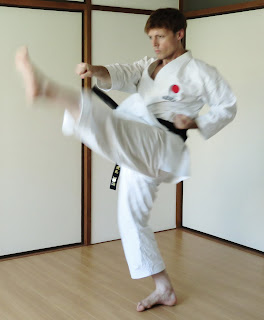
In the recent weeks we've been settling back into Oita. Since moving I decided to go back to the core kihon of karate-do and kihon-kumite; in particular, gohon-kumite (five-step sparring) and kihon ippon-kumite (fundamental one-step sparring). Perhaps paradoxical to those reading this, my kata training has been extremely broad. The reason underpinning this is that I’m currently renewing my tokui-gata. To provide a concrete example of this broadness, yesterdays training concluded with Sochin, Gojushiho Sho, Hangetsu, Nijushiho, Tekki Nidan, Tekki Sandan and Jitte. That being said, and probably needless to say, my focus in kata practice is still ‘kihon-centric’; namely, addressing efficiency and effectiveness of the most fundamental movements.’
Due to the mix/inconsistency of kata I am currently doing, I won’t mention this part of my current training regime today. Likewise, I wont go into my kumite practice (as it has already been outlined above) except to say that jiyu-ippon, uchikomi and jiyu-kumite appear intermittently. However, I will outline the “set kihon” in my routine. Lastly, for those wanting to know my reps, at present I have no set number; instead, I stop when I’ve done enough based on my execution and the daily condition of my body. All the best from sweltering Nippon, “Osu!” - André
SONOBA KIHON
1. Chudan choku-zuki (Hachinoji-dachi).
2. Chudan choku-zuki (Kiba-dachi).
3. Jodan kizami-zuki kara chudan gyaku-zuki (Hidari and migi zenkutsu-dachi).
4. Chudan mae-geri (Heisoku dachi).
5. Chudan mae-geri (Hidari and migi zenkutsu-dachi).
• Isolation practice: Koshi no kaiten in hidari and migi zenkutsu-dachi; and hiza-tsuchi in both heisoku-dachi (and on both sides in zenkutsu-dachi).
1. Chudan choku-zuki (Hachinoji-dachi).
2. Chudan choku-zuki (Kiba-dachi).
3. Jodan kizami-zuki kara chudan gyaku-zuki (Hidari and migi zenkutsu-dachi).
4. Chudan mae-geri (Heisoku dachi).
5. Chudan mae-geri (Hidari and migi zenkutsu-dachi).
• Isolation practice: Koshi no kaiten in hidari and migi zenkutsu-dachi; and hiza-tsuchi in both heisoku-dachi (and on both sides in zenkutsu-dachi).


IDO-KIHON
6. Chudan oi-zuki (Zenkutsu-dachi).
7. Sanbon ren-zuki (Zenkutsu-dachi).
8. Mae-geri kara oi-zuki (Zenkutsu-dachi).
9. Ren-geri: Chudan mae-geri kara jodan mae-geri (Zenkutsu-dachi).
10. Chudan mawashi-geri (Zenkutsu-dachi).
11. Yoko-keage (Kiba-dachi).
12. Yoko-kekomi (Kiba-dachi).
13. Yoko-keage ashi o kaete yoko-kekomi (Kiba-dachi).
14. Jodan age-uke kara chudan gyaku-zuki (Zenkutsu-dachi)
15. Chudan soto-uke kara chudan gyaku-zuki (Zenkutsu-dachi)
16. Chudan soto-uke kara yoko-enpi (Zenkutsu-dachi kara kiba-dachi)
17. Chudan uchi-uke kara chudan gyaku-zuki (Zenkutsu-dachi)
18. Gedan-barai kara chudan gyaku-zuki (Zenkutsu-dachi)
19. Shuto chudan-uke kara nukite (Kokutsu-dachi kara zenkutsu-dachi)
20. Shuto chudan-uke kara kizami mae-geri soshite nukite (Kokutsu-dachi kara zenkutsu-dachi)
• Isolation practice: Advancing and retreating in zenkutsu-dachi and kokutsu-dachi (aiyumibashi/fumidashi); and leftward and rightward movement in kiba-dachi (kosa-aiyumibashi and yori ashi).
© André Bertel. Oita, Japan (2015).
No comments:
Post a Comment
Note: only a member of this blog may post a comment.